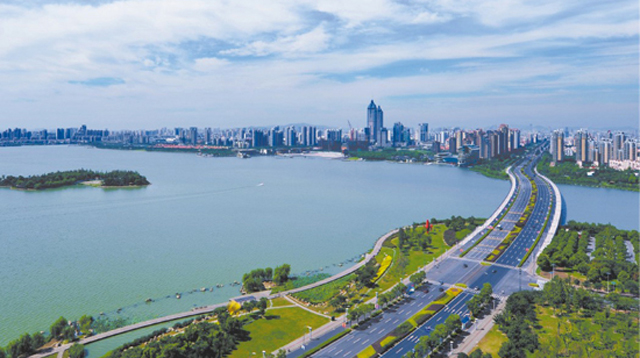
Owing to the importance of SEZs, industrial cooperation has been declared as one of the four integral parts of CPEC. The idea behind is that reliance on industrial parks will enhance bilateral economic and trade cooperation, which will eventually expand collaboration in related industries and promote the development of industrial concentrations in Pakistan.
Swabi industrial zone to be included in CPEC
The initial phase of CPEC is aimed at removing the bottlenecks in infrastructure and energy sectors of Pakistan. Once these constraints are overcome by 2020, plans are in place to establish SEZs in the corridor.
Chinese companies will relocate factories besides inviting local industries to become part of the industrial parks, which will become a focal point of the SEZs.
These parks, with special incentive packages for foreign investors, have to be in place and operational by 2025. Pakistan is still doing paperwork. So far, nine industrial sites have been proposed, one in each of the four provinces, federal capital and special regions of the country.
Chinese have not yet given formal approval to these sites, although expectations are there that they would.
China’s Ministry of Foreign Affairs arranged a visit to the Suzhou Industrial Park last month that gave a fair idea of a successful venture.
The Suzhou park, located in southeast Chinese province of Jiangsu, is treated as a model of inter-governmental cooperation in the world. It has been set up by Singapore and China and is an exemplary industrial, scientific, educational and tourist resort.
Pakistan can replicate this model, which may become a base for building nine new industrial cities with world-class infrastructure.
History of Suzhou park
Suzhou has now become a major commercial hub in Jiangsu, but this involved a lot of planning at the initial stage. In 1994, both Chinese and Singaporean governments decided to develop a modern industrial park in the east of Suzhou.
The park has a total jurisdiction area of 288 km, of which China-Singapore cooperation area covers 80 km with planned residential population of 1.2 million.
A Chinese consortium controls 52% stake, followed by 28% shares for a Singaporean company, 10% for Hong Kong Investment Company, 5% for the district where it is located and the remaining 5% for Singaporean CPC Corporation.
This share structure can be adopted by Pakistan where it will have majority control, but at the same time the Chinese will be involved in better planning and establishment of the economic zones.
China had actually adopted Singapore’s success model for building the Suzhou park. In the first phase, urban planning, construction and land management were done by China. In stage two, economic development got under way that involved a development strategy, investment protection regime, industrial and commercial administrations, a tourism department, offices of customs, finance and taxation and a modernised logistics management chain.
In the last phase, the planners did the public administration job and set up basic educational, vocational and public health institutes and cultural departments. One of the critical aspects was to ensure a ‘corruption-free’ local government.
Now, Suzhou, with only 6% of Chinese population, contributes 10% to the provincial GDP. In 2016, the industrial park generated 490 billion yuan worth of international trade, said Huang Jianming, Director Enterprise Development Bureau.
He said a coordination mechanism was developed to ensure fast and efficient services to the hi-tech industries set up in the park.
To remain competitive around the world, Suzhou authorities offer matching grants for research and development in high-risk areas.
Pakistan’s policy issues
Despite introducing liberal investment policies to lure foreign investors, Pakistan has not yet developed a better coordination mechanism, which is considered one of the major obstacles to foreign investment after security.
Dilapidated roads: Take a bumpy ride in Karachi's Korangi Industrial Area
Energy, infrastructure, administration and governance deficiencies, besides unbalanced regional economic and social development, and external sector vulnerabilities could pose challenges to CPEC.
The Board of Investment has proposed that in order to ensure swift establishment of SEZs, provincial authorities should delegate some powers to the SEZ management, said BOI Chairman Miftah Ismail.
He said Pakistan was cognisant of the problems and was preparing plans to provide new industries with all utility services at factory gates.
The government has not yet sorted out the ownership structure for the SEZs as it is open to federal, provincial and private shareholding. But it is clear that without extra incentives, it will be difficult to attract foreign investment.
For Pakistan, the preferential policy is a way to attract enterprises to set up their units in industrial parks. To attract domestic and foreign enterprises, the industrial parks must formulate comprehensive preferential policies pertaining to land, taxes, logistics and services.
Meanwhile, the industrial parks should improve services and establish windows for one-stop services. Besides, they should guarantee effective implementation of all policies through laws and regulations.
A major challenge is the flow of finances. The industrial parks must, in their development and construction phase, ensure close liaison with financial institutions in China and Pakistan and encourage them to participate in project financing, creating cohesion and jointly building the parks.
The writer is a staff correspondent
Published in The Express Tribune, April 10th, 2017.
Like Business on Facebook, follow @TribuneBiz on Twitter to stay informed and join in the conversation.
1731570357-0/elon-musk-(1)1731570357-0-405x300.webp)
-(1)1717678110-0/Kendrick-(1)-(1)1717678110-0-165x106.webp)















COMMENTS
Comments are moderated and generally will be posted if they are on-topic and not abusive.
For more information, please see our Comments FAQ